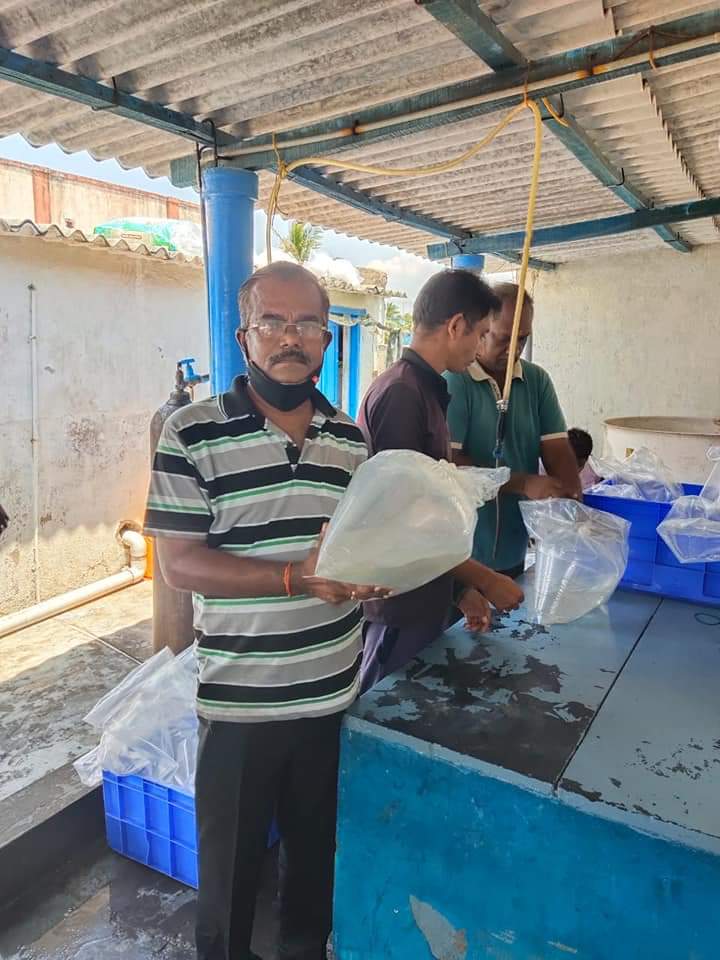CONTROLLING SHRIMP DISEASES BY SELECTING GOOD QUALITY POSTLARVAE
By Sri S.Rajamanickam,Asst chief Technical officer, ICAR-CIBA
Establishing postlarvae quality has become one of the most important aspects in controlling diseases in farmed shrimp. Initial microbial testing can ensure viruses and other pathogens are absent from the animals. Visual evaluation should examine larvae activity and the condition of the hepatopancreas, digestive tract and gills. P.L.10 shrimp are recommended for direct stocking into growout ponds. However, at low-salinity farms, use P.L.12. Appropriate conditions must be maintained during transportation to the farm. Serious economic losses reaching billions of dollars have been caused by viral and bacterial diseases in shrimp farming during the last few years. The quality of postlarvae has become one of the most important aspects in controlling these diseases. Shrimp farmers should apply a series of standard criteria in evaluating postlarvae to be stocked in their ponds.
‘ Stocking Size ‘
The recommended size of shrimp for direct stocking into growout ponds is postlarvae that have been in the postlarvae stage for 10 days (P.L.10), because complete gill development is attained at this stage, making the shrimp capable of withstanding transportation, acclimation and stocking at the farm. However, at farms with salinity below 5 ppt, P.L.12 is the appropriate stage for stocking. A practical way to recognize whiteshrimp postlarval stages is by looking at the number of spines in their rostrums. The P.L. 10 stage has three spines completely developed and a bud of the fourth spine developing in the rostrum, while P.L.12 shrimp have four completely developed spines. On the other hand, weights and ages of shrimp postlarvae directly relate to their stages. So in the hatchery, normally developed larvae should have the following characteristics:
•Day 14 (P.L.4-5) body weight ≤ 1,000 P.L./1 g
.Day 16 (P.L.7-8) body weight ≤ 700 P.L./1 g
•Day 18 (P.L.10) body weight ≤ 300 P.L./1 g.
Another important factor for evaluating shrimp postlarvae in the hatchery is the nauplii stocking density, which should not exceed 100 nauplii/L. It is also important that the water temperature during hatchery culture is maintained at 30 ± 1° C for optimal larval development and quality.
‘ Microbiological Tests ‘
The first criteria to take into account for evaluating shrimp postlarvae quality is to run a series of microbiological tests that will ensure pathogens are absent from the animals. Usually, the following tests are recommended during stage P.L.6 to approve the postlarvae for stocking:Negative result of polymerase chain reaction (PCR) for infectious hypodermal and hematopoietic necrosis virus(IHHNV), infectious myonecrosis virus (IMNV), Taura syndrome virus(TSV), yellow head virus(YHV) and white spot syndrome virus(WSSV),Maximum total bacteria count of 1.0 x 103 CFU/g of larval macerate in agar, of which more than 90% of the colonies should be yellow. Negative presence of Vibrio harveyi (bioluminescent bacteria), which can be detected in agar. If the postlarvae fail to pass any of the microbiological tests, they should be rejected for farm stocking.
‘ Direct Visual Evaluation ‘
After the postlarvae pass the microbiological tests and before transporting them to the farm, direct visual evaluation in the tanks and observations under a light microscope should be done at the hatchery.The following aspects for direct evaluation should be considered.
Larvae activity:
To make sure larval activity is normal, suspend aeration in the larvae tank for a couple of minutes to look for positive rheotaxis – swimming against the water current by the animals.
Hepatopancreas condition:
A large, dark-colored hepatopancreas with a lot of lipid droplets should be observed under the light microscope. A small, whitish hepatopancreas with only a few lipid droplets indicates an infection is occurring.
‘ Digestive tract ‘
Peristaltic movement in the intestine and a muscle:gut ratio of 4:1 in the last abdominal segment are indications of good health.
‘ Fouling and necrosis ‘
Direct observation of postlarvae under the microscope. may detect the presence of Lagenidium species of fungi and/or ciliate protozoa (Zoothamnium, Epistylis, Vorticella species), which usually cause fouling of the postlarvae gills. The presence of these parasites might indicate poor water quality in the larval tank. Eventually, if this situation is not controlled, Leucotrix species (filamentous bacteria)may invade other tissues, causing tissue damage and mortality. A muscle:gut ratio of 4:1 (arrows) is an indication of healthy shrimp.
‘Transport Conditions ‘
Transportation of larvae is an important issue to keep in mind for keeping good larvae quality before stocking. Appropriate oxygen, temperature and food requirements relate to the time required for transportation from the hatchery to the farm.
The following are recommended conditions for transportation:
• Less than four hours of travel: maintain ambient temperature.
• Four to 12 hours of travel: maintain 24 to 28° C.
• More than 12 hours of travel: maintain 18 to 23° C.
• At all distances, a minimum dissolved-oxygen concentration of 5.0 mg/L must be kept.
• For each shrimp postlarva, 15 to 20 Artemia nauplii should be available every four hours.
If the conditions above are not met during transportation, stress of the animals can occur, with an increment in the concentration of ammonia in the water and bacteria within the postlarvae. Eventually, this situation can cause mortality before arrival at the farm, in which case stocking of postlarvae should be suspended.
References:On request.



